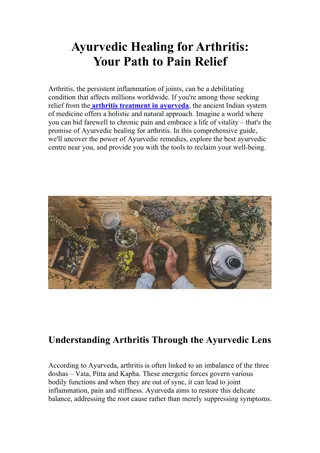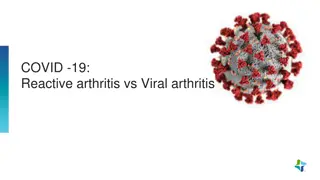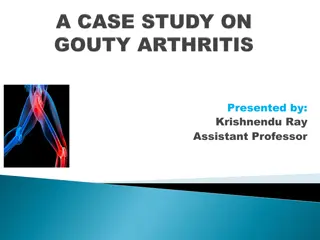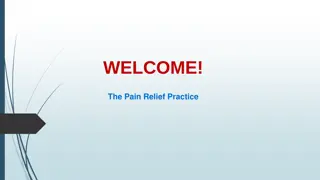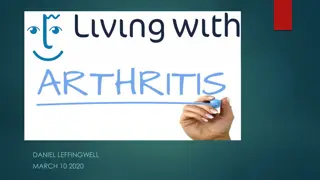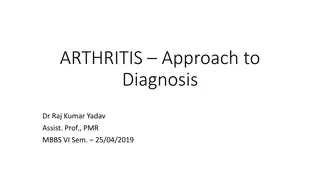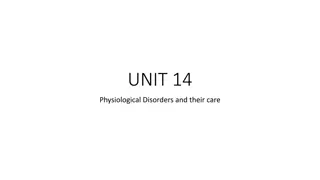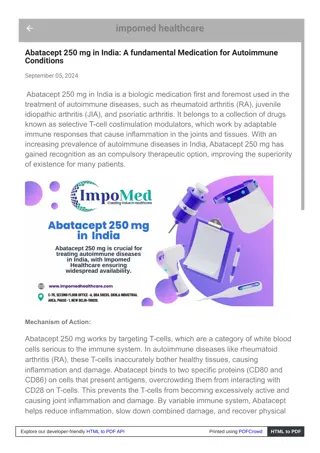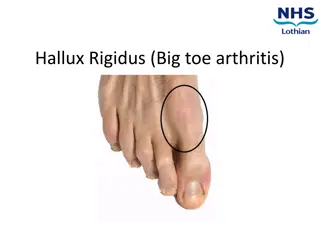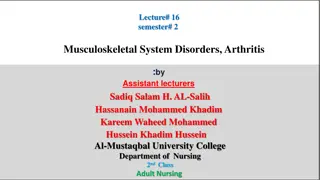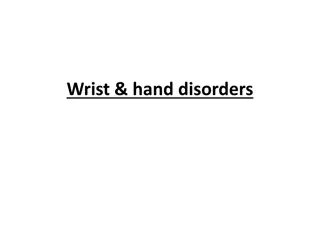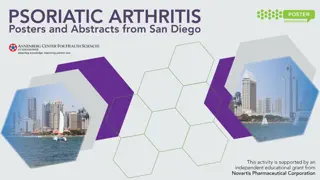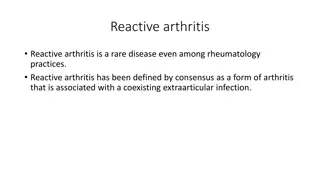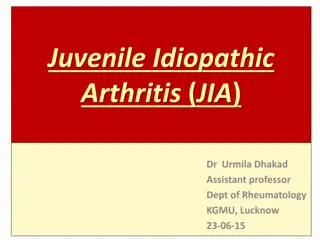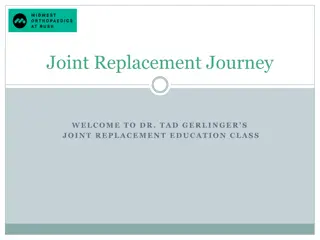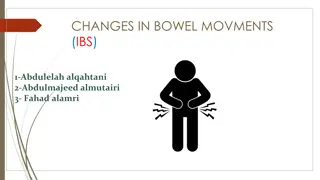Overview of Different Types of Arthritis and Their Symptoms
This informative content provides insights into various types of arthritis such as Osteoarthritis, Rheumatoid Arthritis, Infectious Arthritis, and Juvenile Rheumatoid Arthritis. It discusses their causes, symptoms, and common affected areas to enhance understanding for healthcare professionals and students in the nursing field.
Download Presentation

Please find below an Image/Link to download the presentation.
The content on the website is provided AS IS for your information and personal use only. It may not be sold, licensed, or shared on other websites without obtaining consent from the author. Download presentation by click this link. If you encounter any issues during the download, it is possible that the publisher has removed the file from their server.
E N D
Presentation Transcript
University of Basrah College of Nursing Fundamentals of Nursing Department Second stage Adult Nursing (II) Adult Nursing (II) 2 2nd Stage nd Stage (Theory) ) Lecture Arthritis Lecture 1 1 (Theory - Dr. Dr. Mohamad Mohamad Abdulridha Abdulridha - M.B.CH.B F.I.C.M.S (ORTHO) Orthopedic Surgeon M.B.CH.B F.I.C.M.S (ORTHO) Orthopedic Surgeon -
1. Injury (leading to osteoarthritis). 2. Metabolic abnormalities (such as gout and pseudogout). 3. Hereditary factors. 4. The direct and indirect effect of infections (bacterial and viral) septic joint 5. Misdirected immune system with autoimmunity (such as in rheumatoid arthritis and systemic lupus erythematosus).
Types of arthritis Types of arthritis Symptoms Symptoms Osteoarthritis Osteoarthritis 1. pain in a joint, stiff, and tenderness when pressure is applied to the joint. 2. The patient may find it harder to use the joint . 3. lumps, or bone spurs may appear around the joint. In some cases the joint might swell. 4. The most common affected joints are in the hips, hands, knees and spine.
Rheumatoid arthritis Rheumatoid arthritis 1 1.Symptoms are usually worst on waking up in the minutes at 2 2.The joint is tender when touched. 3 3. . Hands may be red and puffy. 4 4. . There may be rheumatoid nodules (bumps of tissue 5 5.Many patients with rheumatoid arthritis feel tired 6 6. Weight loss is common. .Symptoms are usually worst on waking up in the morning and the stiffness can last for minutes at this time. .The joint is tender when touched. Hands may be red and puffy. There may be rheumatoid nodules (bumps of tissue under the skin of the patient's arms). .Many patients with rheumatoid arthritis feel tired most of the time . Weight loss is common. morning and the stiffness can last for 30 this time. 30 under the skin of the patient's arms). most of the time Infectious arthritis Infectious arthritis 1. fever, joint inflammation and swelling. 2.tenderness and/or a sharp pain. 3. Often these symptoms are linked to an injury , surgery or another illness. 4. Most commonly affected areas are the knee, shoulder, elbow, wrist and finger.
Juvenile rheumatoid arthritis Juvenile rheumatoid arthritis 1 1. . The patient is a child. 2 2. . intermittent fevers which tend to peak in the evening disappear. 3 3. poor appetite and lose weight. 4 4 There may be blotchy rashes on his arms and legs. 5 5. Anemia is also common. 6 6. A joint may suddenly swell and stay larger than it 7 7.The child may experience a stiff neck, hips or some The patient is a child. intermittent fevers which tend to peak in the evening and then suddenly disappear. . poor appetite and lose weight. There may be blotchy rashes on his arms and legs. . Anemia is also common. . A joint may suddenly swell and stay larger than it usually is. .The child may experience a stiff neck, hips or some other joint. and then suddenly usually is. other joint.
Osteoarthritis is a non-inflammatory, degenerative condition of joints Characterized by degeneration of articular cartilage and formation of new bone i.e. osteophytes.
PATHOLOGY At the earliest stages of osteoarthritis, your joints look like this: PATHOLOGY At the earliest stages of osteoarthritis, your joints look like this:
As your osteoarthritis progresses, it looks like this: As your osteoarthritis progresses, it looks like this:
Advancing osteoarthritis looks like this Advancing osteoarthritis looks like this: :
Patients with this level of osteoarthritis usually have pain most of the time: Patients with this level of osteoarthritis usually have pain most of the time:
This is the end stage of disease. Note that there is no cartilage left on the end of the bone: This is the end stage of disease. Note that there is no cartilage left on the end of the bone:
Osteoarthritis symptoms often develop slowly and worsen over time. Signs and symptoms of osteoarthritis include: Pain inactivity 2. Tenderness 3. Stiffness patient wake up in the morning or after a period of inactivity 4. Loss 5. Grating 6. Bone around the affected joint 7. Swelling 8. Deformities Osteoarthritis symptoms most commonly affect the hands, hips, knees and spine. Unless one has been injured or placed unusual stress on a joint, it's uncommon for osteoarthritis symptoms to affect jaw, shoulder, elbows, wrists or ankles. Pain in a joint during or after use, or after a period of 1. Tenderness in the joint when you apply light pressure Stiffness in a joint, that may be most noticeable when Loss of Grating sensation Bone spurs of flexibility sensation when moving the joint spurs, , which appear as hard lumps, may form flexibility may make it difficult to use the joint Swelling in some cases Deformities
Factors that increase risk of osteoarthritis include: Older age. Osteoarthritis typically occurs in older adults. People under 40 rarely experience osteoarthritis. 2. Sex. Women are more likely to develop osteoarthritis, though it isn't clear why. 3. Bone deformities. Some people are born with malformed joints or defective cartilage, which can increase the risk of osteoarthritis. 4. Joint injuries. Injuries, such as those that occur when playing sports or from an accident, may increase the risk of osteoarthritis. 5. Obesity. Carrying more body weight places more stress on weight-bearing joints, such as knees. But obesity has also been linked to an increased risk of osteoarthritis in the hands, as well. 6. Other diseases that affect the bones and joints. Bone and joint diseases that increase the risk of osteoarthritis include gout, rheumatoid arthritis, Paget's disease of bone and septic arthritis. 1.
History & Clinical examination X-rays. X-ray images of the affected joint may reveal a narrowing space within a joint, which indicates that the cartilage is breaking down. An X-ray may also show bone spurs around a joint. Blood tests. Blood tests may help rule out other causes of joint pain, such as rheumatoid arthritis. Joint fluid analysis. Examining and testing the synovial fluid can determine if pain is caused by gout or an infection. Arthroscopy. In some cases, arthroscopy to see inside the joint in order to determine the cause of pain. During arthroscopy, small incisions are made around the joint and a tiny camera is inserted to see inside the joint 1. 2. 3. 4. 5.
There's no known cure for osteoarthritis, but treatments can help to reduce pain and maintain joint movement so that patient can go about his daily tasks. While medications and joint replacement surgery are key components of treatment for osteoarthritis, doctor will likely recommend to try all other possible solutions before one can consider those options. Eventually the pain may become severe so that medications and eventually surgery may become necessary.
Rest. for 12 to 24 hours. Find activities that don't require use joint repetitively. 1. Exercise. regular exercise, Stick to gentle exercises, such as walking, biking or swimming. Exercise can strengthen the muscles around joint, making it more stable. 2. Weight reduction. Being overweight or obese increases the stress on weight-bearing joints, knees and hips. Even a small amount of weight loss can relieve some pressure and reduce pain. 3. Heat and cold to manage pain. Heat also relieves stiffness and cold can relieve muscle spasms. 4. Work with a physical therapist. 5. Walking aids 6. Find ways to avoid stressing joints. 7. Apply over-the-counter pain creams. 8. Consider trying special splints, braces, shoe inserts or other medical devices that can help reduce pain. 9. 10. Chronic pain class. These classes teach skills that help to manage osteoarthritis pain. And patient will meet other people with osteoarthritis and learn their tips for reducing joint pain .
Osteoarthritis pain that persists despite initial treatment may require medications in addition to initial treatment options. In order to get the most from treatment, continue exercising when possible and rest when needed. If overweight, continue weight loss . Medications that may be useful for moderate arthritis include: Acetaminophen. relieve pain, but doesn't reduce inflammation. It has been shown to be effective for people with osteoarthritis who have mild to moderate pain. NSAIDs. can relieve pain and reduce inflammation. Ibuprofen, naproxen , and others. NSAIDs have risks of side effects that increase when used at high dosages for long-term treatment. Side effects may include gastric ulcers, cardiovascular problems, gastrointestinal bleeding, and liver and kidney damage. Tramadol. is a centrally acting analgesic that has no anti- inflammatory effect, but can provide effective pain relief with fewer side effects - such as stomach ulcers and bleeding - than those of NSAIDs. However, tramadol may cause nausea and constipation. It's generally used for short-term treatment of acute flare-ups.
If you've tried other treatments but your patient still experiencing severe pain and disability, you and your patient can discuss other treatments including: Stronger painkillers. such as codeine and propoxyphene may provide relief from more severe osteoarthritis pain. These stronger medications carry a risk of dependence, Cortisone shots. Injections of corticosteroid medications may relieve pain in joint. It isn't clear how or why corticosteroid injections work in people with osteoarthritis. too many corticosteroid injections may cause joint damage. Visco-supplementation. Injections of hyaluronic acid derivatives may offer pain relief by providing some cushioning in the joint . Injections are typically given weekly over several weeks or once a year. Pain relief may last for a few months. Possible risks include infection, swelling and joint pain.
Surgery is generally reserved for severe osteoarthritis that isn't relieved by other treatments. Surgical treatments include: . Debridement ,is most useful in cases with a locking sensation from a torn cartilage or loose debris Debridement is typically done arthroscopically, Fusing bones. Surgeons also can permanently fuse bones in a joint (arthrodesis) to increase stability and reduce pain. The fused joint, such as an ankle, can then bear weight without pain, but has no flexibility. Realigning bones. Surgery to realign bones may relieve pain. These types of procedures are typically used when joint replacement surgery isn't an option, such as in younger people with osteoarthritis. During a procedure called an osteotomy, the surgeon cuts across the bone either above or below the knee to realign the leg. Joint replacement. In joint replacement surgery (arthroplasty), surgeon removes damaged joint surfaces and replaces them with plastic and metal devices called prostheses. Joint replacement surgery can help patients resume an active, pain-free lifestyle. Joint replacement surgery carries a small risk of infection and bleeding. Artificial joints can wear or come loose, and may need to eventually be replaced
Arthroscopy- joint debridement to remove interfering osteophyte, cartilage tags and loose bodies may provide temporary relief from symptoms but does not stop the progression of OA Arthroscopic view of the removal of cartilaginous loose body.
Principle: To redistribute loading forces towards less damaged parts of the joint e.g to shift weight from the damaged cartilage on the medial aspect of the knee to the healthy lateral aspect of the knee
1. Causes of arthritis 2.Know type of Arthritis 3. General outline in management of arthritis



